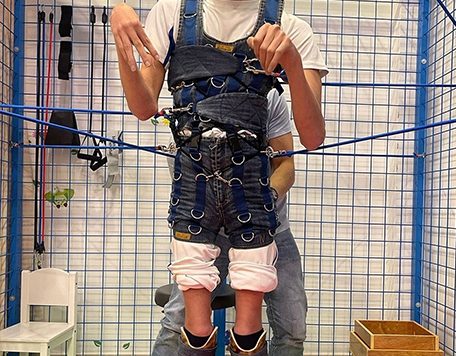Intensive pediatric therapy is revolutionizing the face of rehabilitation for children with motor delay, neurological disorders, and developmental challenges. While most therapies might be conducted once or twice a week, intensive therapies offer high-frequency, structured treatment designed to increase the rate of progress and maximize functionality. Among the most effective and innovative approaches in pediatric intensive therapy are Dynamic Movement Intervention, Cuevas Medek Exercise, Suit Therapy, and Spider Cage. These approaches assisted children in gaining strength, coordination, and independence.
What is Pediatric Intensive Therapy?
Pediatric intensive therapy is practiced with the child undergoing frequent, structured, and high-repetition therapy sessions—usually for several hours a day for a few weeks. This provokes neuroplasticity to facilitate forming new neural connections for better motor control, balance, and coordination.
It helps children with conditions like Cerebral Palsy, Down Syndrome, developmental delays, and genetic disorders by incorporating specialized techniques such as DMI, CME, Suit Therapy, and the Spider Cage to attain greater functional independence and improved mobility.
1. Dynamic Movement Intervention (DMI)
DMI is a revolutionary therapy that provokes and strengthens motor skills through graded exercises that activate postural control and movement patterns. It further enables a child with mobility impairment to achieve core strength, balance, and coordination by triggering his natural reflexes and movement responses.
Advantages of DMI
- Stimulates the nervous system for gross motor skill improvement
- Encourages independent movements and postural control
- Promotes neuromuscular re-education
- Increases strength and stability for sitting, crawling, and walking
2. Cuevas Medek Exercise (CME)
CME or Cuevas Medak Exercise is a practical therapy that works on postural control and balance reactions by exposing children to exercises dependent on gravity. In contrast to passive therapies, CME actively involves children in movements challenging their motor responses and new pathways for movement development.
Advantages of CME:
- Develops postural control for standing and walking
- Strengthen antigravity movements
- Improves automatic balance reactions
- Develops muscle endurance and coordination
CME is particularly effective for those children who are unable to achieve motor milestones such as rolling, sitting, standing, or walking.
3. Suit Therapy
Suit Therapy is also known as Thera Suit or Adeli Suit Therapy, where a specific suit with elastic bands provides resistance and proprioceptive input. The method re-trains the body and brain in better movement patterns, strength, and coordination.
Benefits of Suit Therapy:
- Enhance posture, strength, and alignment
- Improves muscle tone regulation
- Enhances joint stability and flexibility
- Reinforces correct movement patterns
Treatment using a suit is usually coupled with other therapies, such as DMI, CME, and the Spider Cage, for maximum benefits to be achieved.
4. The Spider Cage
The Spider Cage, or Universal Exercise Unit, is a dynamic therapy tool using a system of elastic bungee cords that provides partial weight-bearing support. This way, children can practice movements in a controlled environment, and they are able to safely explore movement with support, which makes it a great tool for children who have balance and coordination challenges.
Advantages of the Spider Cage
- Strengthens muscles in a supported environment
- Develops independent movement without fear of falling
- Enhances proprioception and spatial awareness
- Improves motor planning and coordination
By removing gravitational constraints, the Spider Cage allows children to perform exercises they may not be able to do on their own, providing them with the confidence and motivation to improve their motor skills.
Why Choose Pediatric Intensive Therapy?
Pediatric intensive therapy achieves results in a more rapid and meaningful way as opposed to the traditional approaches to therapy. The DMI, CME, and Suit Therapy combined with the Spider Cage provides a holistic, multi-level rehabilitation intervention that addresses movement development from all angles.
Some of the Key Advantages of Intensive Therapy
- Rapid improvement in mobility and functions
- Improved muscle tone and strength
- Improved coordination and balance
- Improved motor planning
- Improved independence in daily life
- Higher motivation and confidence in movement skills
For kids dealing with neurological and developmental issues, intensive therapy can be a breakthrough, allowing them to do things they thought were not possible to do a long time ago.
Conclusion
Life-altering benefits have been seen from pediatric intensive therapy, which includes DMI, CME, Suit Therapy, and Spider Cage. These are effective therapies applied in a multifaceted manner to strengthen the muscles, increase balance, and lead to a higher level of independence, hence allowing children with motor challenges to achieve their best.
If you want to have your child undergo intensive therapy, contact a specialized pediatric therapy center that will help develop a personalized plan to suit the child’s needs. With proper interventions and concerted effort, one can achieve incredible progress.
Hope AMC Riyadh offers the best of advanced pediatric therapies for children. Reach out to us today to see how our intensive therapy programs can benefit your child!


